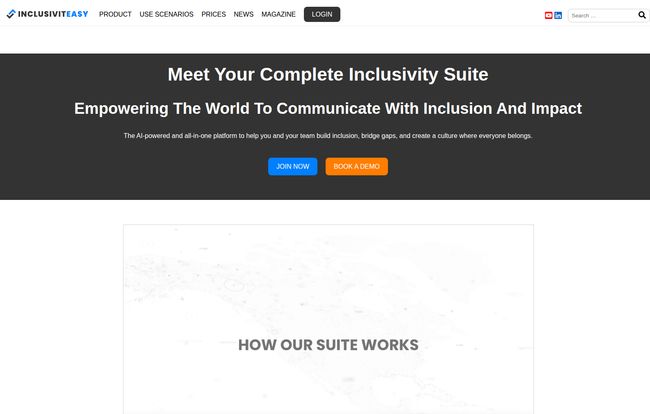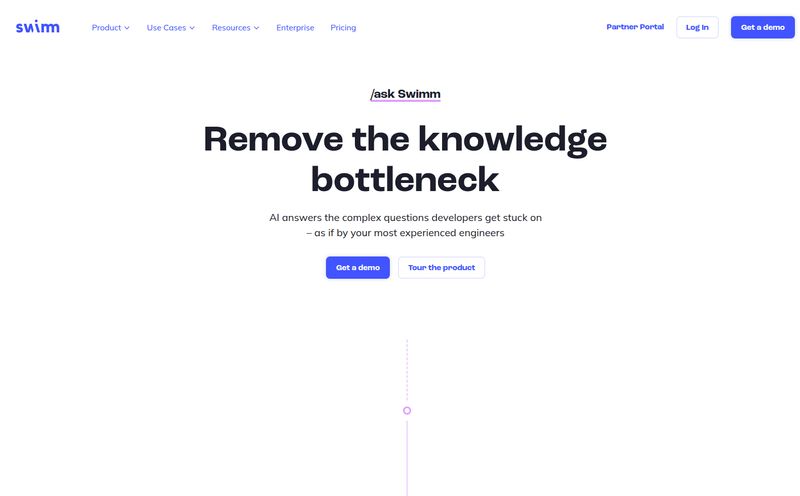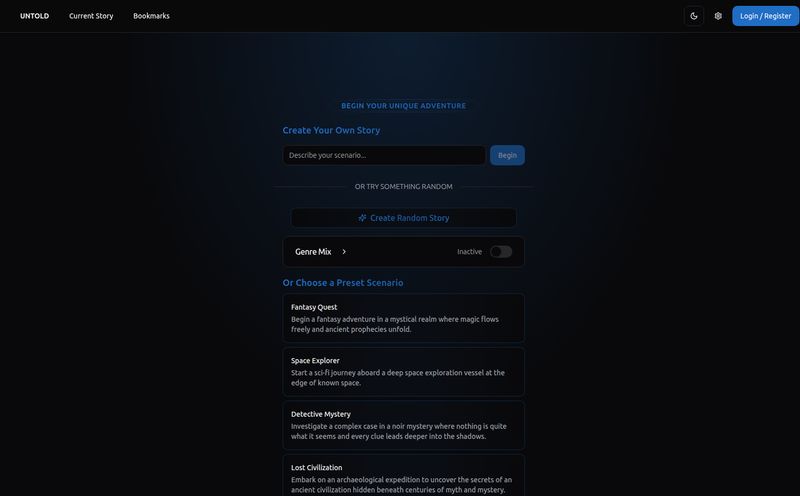We've all been there. You’re typing away, crafting what you think is the perfect blog post, email, or social media update. You hit publish. And then... crickets. Or worse, that one comment that points out a phrase you used is outdated, unintentionally exclusive, or just plain cringey. It’s a gut-punch. In the world of SEO and digital marketing, our words are our currency. One wrong phrase can alienate a whole segment of your audience, tank your engagement, and make your brand look like it’s stuck in the dial-up era.
For years, we've had spell checkers and grammar tools. Grammarly is practically a required install for anyone who writes more than a tweet a day. But what about checking for… well, for being a considerate human? That's a much trickier needle to thread. Language evolves. What was perfectly fine five years ago might land you in hot water today. This is the exact problem a tool called InclusivitEasy claims to solve.
I’ve been hearing whispers about it, so I decided to take it for a spin. Is it just another piece of tech-for-good vaporware, or is it a genuinely useful addition to the modern writer's toolkit? Let's get into it.
So, What Exactly is InclusivitEasy?
At its core, InclusivitEasy is an AI-powered platform designed to act as a sensitivity reader for your digital content. Think of it as a partner that scans your text not for misplaced commas, but for misplaced assumptions. It identifies language that might be non-inclusive, biased, or exclusionary and then—and this is the important part—suggests better alternatives.
It’s not about policing your language or enforcing some kind of rigid, politically correct doctrine. I was skeptical about this at first, I'll admit. The last thing I need is another robot telling me what to do. But from what I've seen, it’s more about broadening your perspective. It helps you consider how your words might land with people from different backgrounds, abilities, genders, and experiences. It’s about making your content resonate with more people, not fewer. And in the traffic-generation game, that’s always the goal, isn’t it?

Visit InclusivitEasy
Putting the Tool to the Test: A Walkthrough
The process is refreshingly straightforward. There's no steep learning curve or clunky interface to fight with. The platform itself is slick, its easy to get started. It basically boils down to a four-step flow:
- Write Your Text: You start by either pasting your text directly into their editor or, I assume, integrating it with your existing workflow (they mention integration). This could be anything from a new website landing page to an internal HR document.
- Let the AI Review: You run the analysis. The AI quickly scans your content, flagging words and phrases that could be problematic.
- Get Suggestions: This is where the magic happens. Instead of just saying “Hey, this is bad,” it provides context and offers inclusive alternatives. For example, it might flag “hey guys” and suggest “hey everyone” or “hi team.”
- Analyze and Learn: Beyond just a simple find-and-replace, the tool aims to educate. It gives you insights into why a certain term is flagged, helping you become a more conscious writer over time.
It’s less of a strict schoolmarm correcting your homework and more of a helpful colleague leaning over your shoulder and saying, “You know, there might be a better way to phrase that.”
The Bottom Line: Why This Matters for Your Bottom Line
Okay, the warm-and-fuzzy aspect is nice, but I'm an SEO guy. I care about metrics. Traffic, conversions, bounce rates. So why should a performance-focused marketer care about inclusive language? The answer is simple: because your audience does.
InclusivitEasy throws some pretty compelling stats on their site, and they align with what I've seen in the industry for years. They state that 75% of consumers are more loyal to brands that actively support social equality. That's not a small number. That’s three-quarters of your potential market. When people feel seen and respected by a brand, they don't just buy from you; they become advocates for you.
They also mention that 64% of consumers take some kind of action after seeing an ad they consider to be diverse or inclusive. In a world where we fight for every single click and conversion, that’s a massive lever to pull. Using inclusive language isn't just about avoiding PR disasters; it's a genuine growth strategy. It builds trust, fosters community, and directly impacts user behavior. It’s the difference between a user hitting the back button and a user thinking, “Okay, these guys get it.”
A Look Under the Hood
So what are the actual features that make this thing tick? It’s not just a one-trick pony.
AI-Powered Bias and Language Checker
This is the engine of the whole platform. It goes beyond obvious slurs or insults and picks up on subtle biases that can creep into our writing. This could be anything from ableist language (like saying something is “lame”) to gendered assumptions (like using “mankind” instead of “humanity”).
Smart Suggestions and Educational Nudges
I really like this part. The tool doesn't just put a red line through a word. It explains the ‘why’. This turns a simple correction into a teachable moment. Over time, you’re not just fixing mistakes; you’re internalizing the principles and becoming a better communicator without even trying. The educational resources they mention are a big plus, transforming it from a simple SaaS tool into more of a training platform.
Let's Talk Money: The InclusivitEasy Pricing Model
Alright, so how much does this empathy spell-checker cost? InclusivitEasy uses a token-based system, which is pretty common for API-driven services. It’s a pay-as-you-go approach, which can be good for some, but less so for others.
Here’s the breakdown: 1 token = 500 words. That’s a decent chunk of text, about the length of a standard blog post intro or a substantial email.
| Plan | Tokens | Price | Cost Per 500 Words |
|---|---|---|---|
| Basic | 50 | €15.00 | €0.30 |
| Standard | 100 | €28.00 | €0.28 |
| Pro | 250 | €62.50 | €0.25 |
| Ultimate | 500 | €110.00 | €0.22 |
They also have an Enterprise option for large teams. The pricing seems reasonable, especially when you consider the cost of one bad marketing campaign or a damaged brand reputation. A single PR crisis can cost thousands, if not millions. Spending €0.30 to check a blog post seems like a pretty good insurance policy.
The Good, The Bad, and The Nitty-Gritty
No tool is perfect. After digging in, here’s my honest take on the pros and cons.
What I Like
The core concept is fantastic and, frankly, necessary. It addresses a real, tangible need for content creators, marketers, and HR departments. The user interface is clean and it seems incredibly easy to use. I appreciate that it promotes equality and respect not as a chore, but as a path to better communication and business results. The flexible pricing means a solo blogger can get in on the action without committing to a huge monthly fee.
What Could Be Better
Here's where I have a couple of reservations. First, the platform currently only supports neutral English. In a global market, this is a significant limitation. I work with clients who need content in UK English, Australian English, and other variants, not to mention other languages entirely. I hope expanding language support is high on their roadmap.
The other point is a personal pet peeve of mine: the tokens expire after 6 months. I understand the business reason—it encourages usage and predictable revenue—but as a user, it feels a bit like buying a carton of milk you know you might not finish before it goes bad. For freelancers or agencies with fluctuating workloads, this could lead to wasted money, which never feels good.
The Final Verdict: Is InclusivitEasy a Must-Have?
So, do you need to rush out and buy InclusivitEasy tokens right now?
My answer is… it depends. If you're a large organization, a public-facing brand, or an HR team, the value is incredibly clear. It’s a safety net, a training tool, and a brand-building asset all in one. The cost is minimal compared to the risk of getting it wrong. For a marketing team, this is a no-brainer to run final copy through before it goes live.
If you're a smaller creator or a solo blogger, it’s still a powerful tool to have in your arsenal. It might not be something you use every single day, but for those pillar pieces of content, those important website pages, or that big email campaign, it's absolutely worth the small investment to ensure your message lands perfectly. Despite its current limitations, InclusivitEasy is a step in the right direction. It’s a tool built for the modern internet—one that recognizes that connection is built on respect, and respect is built on thoughtful language.
Frequently Asked Questions
- 1. Is InclusivitEasy difficult to use for non-techy people?
- Not at all. Based on its design and workflow, it's made for writers and communicators, not developers. If you can copy and paste text, you can use this tool.
- 2. How does the token system work?
- It's a credit system. You buy a bundle of tokens, and each time you analyze a piece of text, it deducts tokens. One token covers up to 500 words, which is roughly a page of text or a short blog post.
- 3. Will InclusivitEasy make my writing sound robotic or censored?
- That’s a common fear with tools like this. From my analysis, its goal isn't to censor but to suggest. You always have the final say. It provides options and explanations, allowing you to maintain your unique voice while being more considerate of a diverse audience.
- 4. What kind of bias does it actually detect?
- It's designed to flag a wide range of potential issues, including but not limited to gendered language, ableism, ageism, racial bias, and other subtle forms of non-inclusive phrasing that often go unnoticed.
- 5. Can I use it for languages other than English?
- Currently, no. The tool is limited to neutral English. This is one of its main drawbacks at the moment, but hopefully, they will expand to other languages and regional English variations in the future.
- 6. What happens if I don't use all my tokens in 6 months?
- Unfortunately, they expire. This is a key consideration when choosing a pricing plan. It’s best to estimate your usage and buy a package that you're confident you'll use within that timeframe.



